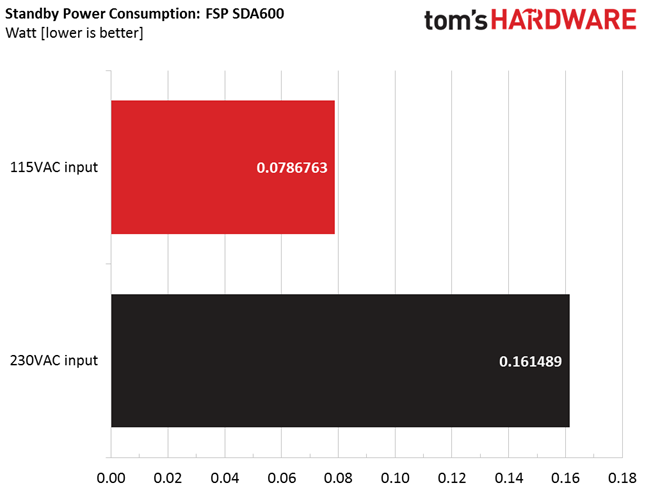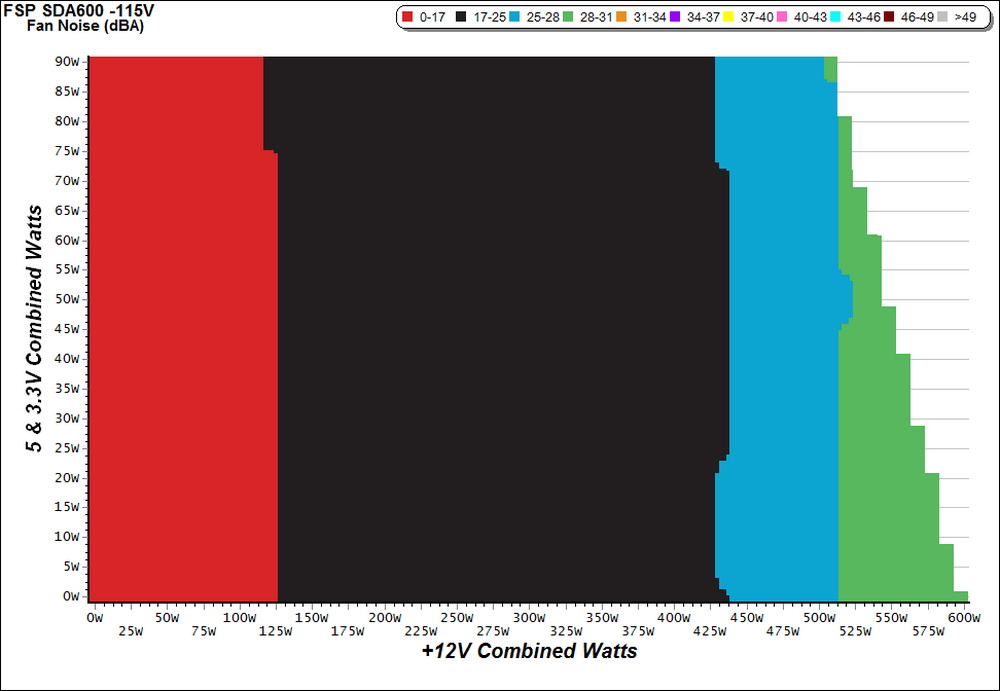FSP Dagger 600W SFX PSU Review
Why you can trust Tom's Hardware
Efficiency, Temperature & Noise
Efficiency
Our efficiency testing procedure is detailed here.
Using the previous page's results, we plotted a chart showing the SDA600's efficiency at low loads, and loads from 10 to 110 percent of its maximum-rated capacity.




Efficiency-wise, the 600W Dagger doesn't score so well compared to its SFX-based competition. Corsair raised the bar quite high with its SF line, which employs a Great Wall platform. Of course, the Lian Li and SilverStone SX700-LPT units belong to a higher efficiency category, so they cannot be directly compared to the SDA600.
Efficiency At Low Loads
In the following tests, we measure the SDA600's efficiency at loads significantly lower than 10 percent of its maximum capacity (the lowest load the 80 PLUS standard measures). The loads we dialed were 20, 40, 60, and 80W. This is important for representing when a PC is idle, with power-saving features turned on.
| Test # | 12V | 5V | 3.3V | 5VSB | DC/AC (Watts) | Efficiency | Fan Speed | Fan Noise | PF/AC Volts |
|---|---|---|---|---|---|---|---|---|---|
| 1 | 1.210A | 0.503A | 0.470A | 0.196A | 19.673 | 67.286% | 1275 RPM | 18.3 dB(A) | 0.924 |
| 12.069V | 4.975V | 3.392V | 5.042V | 29.238 | 115.13V | ||||
| 2 | 2.447A | 1.001A | 0.972A | 0.396A | 39.786 | 78.472% | 1359 RPM | 18.6 dB(A) | 0.968 |
| 12.065V | 4.973V | 3.389V | 5.034V | 50.701 | 115.13V | ||||
| 3 | 3.684A | 1.497A | 1.475A | 5.026A | 59.854 | 82.647% | 1415 RPM | 19.1 dB(A) | 0.985 |
| 12.061V | 4.975V | 3.388V | 5.026V | 72.421 | 115.13V | ||||
| 4 | 4.910A | 2.014A | 1.949A | 0.796A | 79.807 | 84.282% | 1506 RPM | 19.5 dB(A) | 0.991 |
| 12.059V | 4.973V | 3.384V | 5.017V | 94.690 | 115.13V |
We don't want to see lower than 70% efficiency with 20W load, and as you can see in the table above, FSP's SDA600 fails to meet our demands. With 40W load, efficiency improves quite a bit. But it's still below 80%. More taxing loads are needed to get this PSU above the 80% mark.
5VSB Efficiency
The ATX specification states that 5VSB standby supply efficiency should be as high as possible, recommending 50 percent or higher with 100mA of load, 60 percent or higher with 250mA of load, and 70 percent or higher with 1A or more of load.
We take four measurements: one each at 100, 250, and 1000mA, and one with the full load the 5VSB rail can handle.
Get Tom's Hardware's best news and in-depth reviews, straight to your inbox.
| Test # | 5VSB | DC/AC (Watts) | Efficiency | PF/AC Volts |
|---|---|---|---|---|
| 1 | 0.102A | 0.513 | 68.767% | 0.088 |
| 5.049V | 0.746 | 115.09V | ||
| 2 | 0.252A | 1.271 | 73.383% | 0.183 |
| 5.045V | 1.732 | 115.08V | ||
| 3 | 1.003A | 5.035 | 73.429% | 0.391 |
| 5.024V | 6.857 | 115.09V | ||
| 4 | 2.502A | 12.460 | 72.895% | 0.477 |
| 4.982V | 17.093 | 115.09V |


The 5VSB rail's efficiency is really disappointing. This is clearly illustrated by the ETA efficiency rating of this unit, since it should be ETA-A. Because it doesn't meet the required 5VSB efficiency requirement, it drops to ETA-A-.
Power Consumption In Idle And Standby
In the table below, you'll find the power consumption and voltage values of all rails (except -12V) when the PSU is idle (powered on, but without any load on its rails), and the power consumption when the PSU is in standby mode (without any load, at 5VSB).
| Mode | 12V | 5V | 3.3V | 5VSB | Watts | PF/AC Volts |
|---|---|---|---|---|---|---|
| Idle | 12.076V | 4.977V | 3.395V | 5.042V | 7.673 | 0.206 |
| 115.3V | ||||||
| Standby | 0.0786763 | 0.009 | ||||
| 115.1V |


Vampire power is kept at low levels with both inputs (115V and 230V).
Fan RPM, Delta Temperature, And Output Noise
Our mixed noise testing is described in detail here.
The first chart below illustrates the cooling fan's speed (in RPM), and the delta between input and output temperature. The results were obtained at 37°C (98.6°F) to 46°C (114.8°F) ambient temperature.
The next chart shows the cooling fan's speed (again, in RPM) and output noise. We measured acoustics from one meter away, inside a hemi-anechoic chamber. Background noise inside the chamber was below 16.6 dB(A) during testing (actually, it was much lower, but our sound meter’s microphone cannot measure below that threshold), and the results were obtained with the PSU operating at 37°C (98.6°F) to 46°C (114.8°F) ambient temperature.
The following graph illustrates the fan's output noise over the PSU's operating range. The same conditions of the above graph apply to our measurements, though the ambient temperature was between at 30°C (86°F) to 32°C (89.6°F).
Although this PSU doesn't feature a semi-passive mode, its fan still rotates at low RPM up to around 125W loads. In the 125W-430W range, output noise is kept below 25 dB(A), while even in the worst-case scenario noise doesn't exceed 31 dB(A). It is really nice to see a quiet SFX-based PSU.
MORE: Best Power Supplies
MORE: How We Test Power Supplies
MORE: All Power Supply Content
Current page: Efficiency, Temperature & Noise
Prev Page Load Regulation, Hold-Up Time & Inrush Current Next Page Protection Features
Aris Mpitziopoulos is a contributing editor at Tom's Hardware, covering PSUs.
-
DarkSable I won't. FSP is a known OEM; arguably the second greatest on the market. The original Silverstone power supplies were made by FSP, while the new ones and Corsair's offerings are made by Great Well, which although doing a good job on Corsair's SFX psus, is not known for their reliability.Reply


